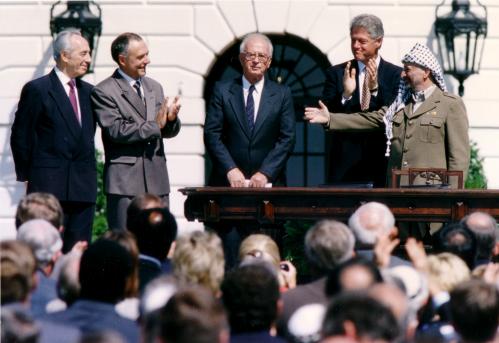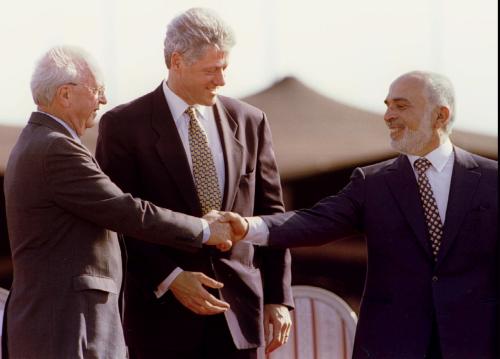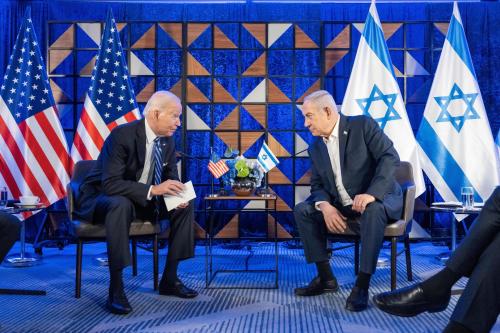On the eve of their 25th anniversary, the debate over the Oslo Accords focuses on their pros and cons, the question of who should get credit, and whether the Oslo framework is dead or in need of revision and rebooting.
In this context, there is more than a touch of irony to the fact that for one of its principal authors—Israeli Prime Minister Yitzhak Rabin—Oslo was a fallback option. Rabin was ambivalent about the Oslo Accords: He preferred a Syria-first policy and decided to go ahead with the Oslo negotiations only when he discovered that he had no viable Syrian option, at least in the summer of 1993.
A dual-track approach
During the campaign for his election in 1992, Rabin spoke against withdrawal from the Golan Heights and promised, if elected, to reach an agreement on an autonomy arrangement with the Palestinians within nine months after the formation of his government. At that time, Rabin was a staunch opponent of any give-and-take with the Palestine Liberation Organization (PLO).
But soon after the formation of his government, Rabin changed his mind: He became willing to consider a peace deal with Syria, modeled after the Israeli-Egyptian peace treaty of 1979 (with the basic model being full peace in exchange for full withdrawal). Why the change of heart? U.S. Secretary of State James Baker told Rabin in the summer of 1992 that Syrian President Hafez al-Assad had told him that he was willing to make such a peace with Israel and that the Bush administration was willing to underwrite it. Rabin’s approach was then to negotiate on both the Syrian and Palestinian tracks and see which of them would yield the first breakthrough. In their first working meeting in March 1993 President Clinton, who had himself adopted a Syria-first policy, tried to get Rabin to commit to that. Rabin insisted on seeking a breakthrough on both tracks. While expressing a willingness to make a massive territorial concession in the Golan, Rabin declined to commit to a full withdrawal from that territory.
During the next four months, participants in the clandestine Israeli-Palestinian Track II dialogue in Oslo reached a breakthrough, while the Israeli-Syrian negotiation was hindered by Assad’s refusal to explain what, in his view, peace with Israel entailed—whether it included full normalization and what the security arrangements might be—before Israel committed to a full withdrawal from the Golan. All efforts by the Clinton administration to persuade Assad to adopt a more flexible attitude failed. Rabin had endorsed the Oslo channel a few weeks after it was launched and monitored its progress, but remained ambivalent about it.
Rabin’s Syria gambit
Matters came to a head in early August 1993. On August 3, Secretary of State Warren Christopher and his team came to see Rabin in his office in Jerusalem. On August 4, they were to meet Assad in Damascus. It was then that Rabin surprised Christopher (and everybody else) by giving him the “deposit”: a hypothetical, conditional willingness to withdraw fully from the Golan in return for an upgraded version of the package of peace and security that Egypt’s Anwar Sadat had given Israel’s Menachem Begin in 1979. Rabin began cautiously, asking Christopher to ask Assad whether “if he gets what he wants, will he give me what I want?” He proceeded to offer a detailed description of what he had in mind. Rabin told Christopher that this was a strict secret, something to be “kept in his pocket” that “must not be put on the table”.
Among other things that the surprised Christopher asked Rabin, given this dramatic and surprising turn, was what would happen on the Palestinian front (he had been briefed by his team on the impending agreement in Oslo). Rabin’s response was that in the event of an agreement with Syria, the agreement with the Palestinians would be limited to Gaza.
Rabin’s gambit was motivated by his realization that he had reached a moment of truth. The nine-month breakthrough that he had promised the Israeli public had yet to happen. The Oslo Accord was almost ready to be signed and his partner-rival Foreign Minister Shimon Peres was anxious to complete the process. And yet Rabin was ambivalent about Oslo and would rather make his first major move on the Syrian track. The deposit with Christopher was his way of trying to find out, at the last minute, whether he had a viable Syrian option.
Left with few choices
In the next few days, he found out that he did not. Christopher and his team came back from Damascus with what they saw as good news. Assad said yes in principle, but he wanted to modify and downgrade most of Rabin’s conditions. Rabin realized that Christopher did, after all, put his deposit on the table, and that a lengthy bargaining process lay ahead with Christopher as the go-between. Rabin also understood that his part of the bargain, Israel’s withdrawal had become a given, while Assad’s part of the bargain would have to be negotiated.
Rabin was also surprised to hear that the U.S. team was about to fly back home for the summer vacation. He had no time. Refusing to authorize the Oslo Accord or insisting on postponing it would mean a confrontation with Peres. With a Syria breakthrough under his belt, Rabin could have weathered such a confrontation, but that breakthrough had just eluded him. And so Rabin gave the green light to conclude the Oslo Accord, and we are left with the tantalizing counterfactual question: How would the peace process have proceeded on a Syria-first rather than a Palestine-first track?








Commentary
The Oslo Accords at 25: The Syria track that could have been
September 11, 2018